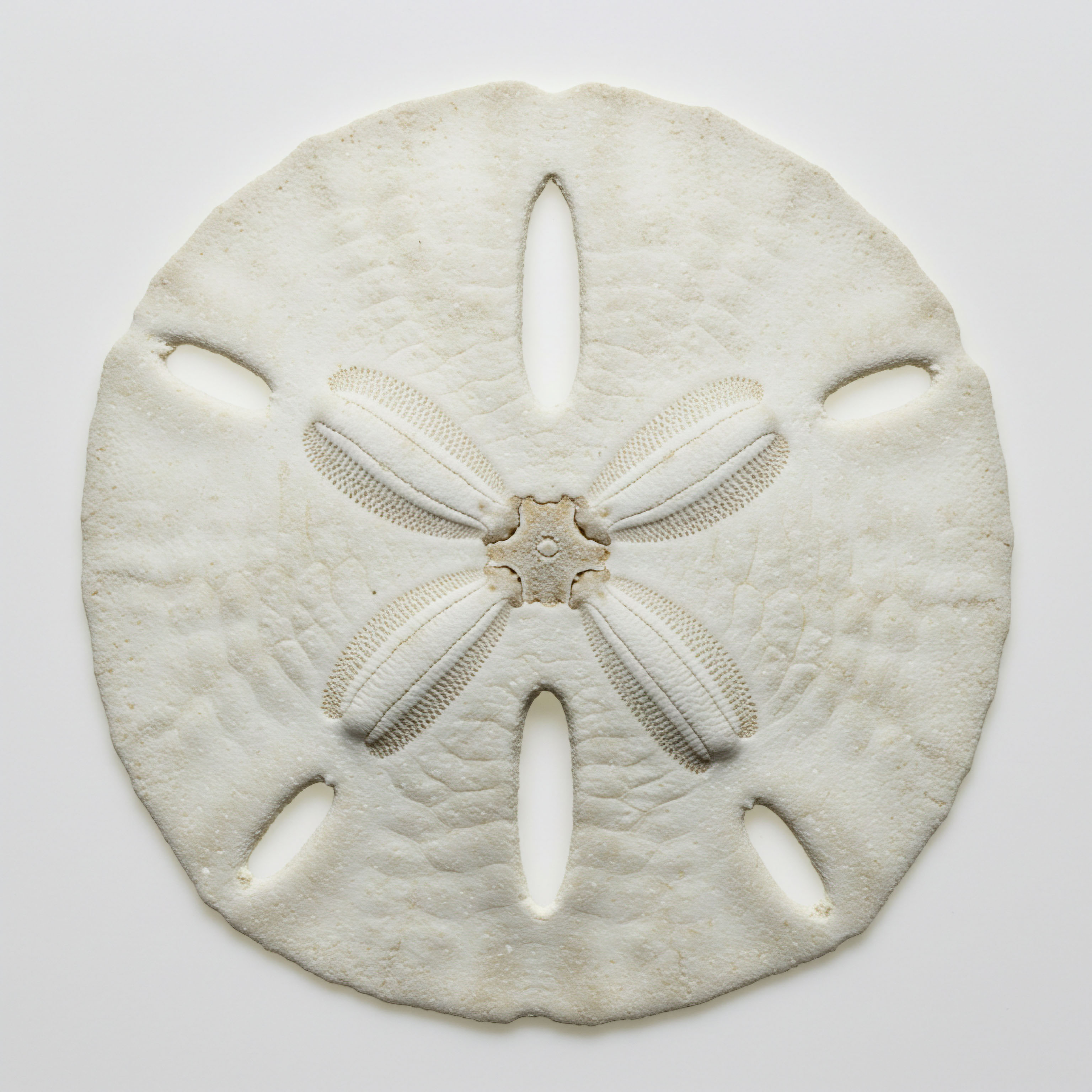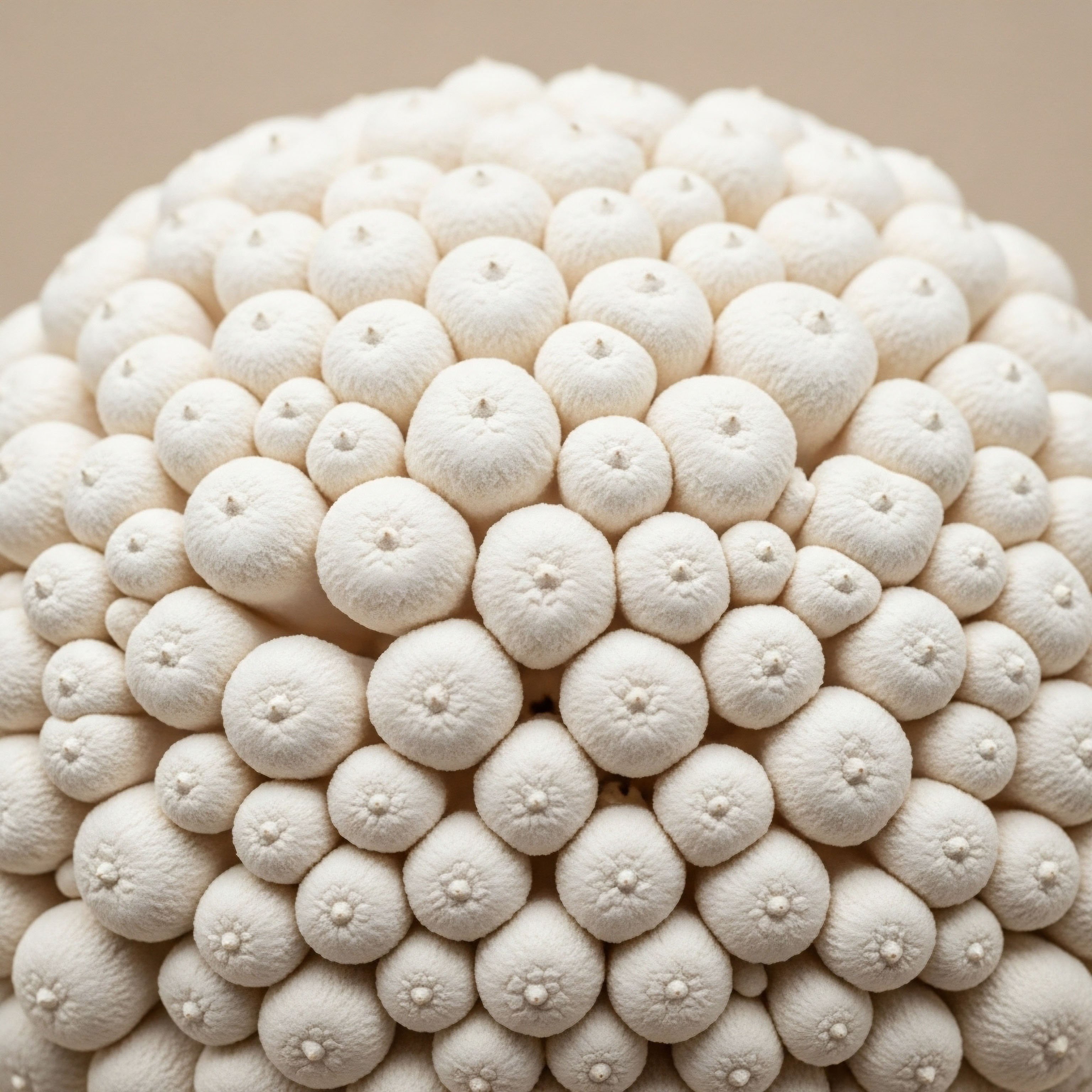

Fundamentals
You feel it as a subtle shift in your internal landscape. The energy that once propelled you through demanding days now seems to wane sooner. Motivation, once a reliable inner fire, requires more effort to stoke. You might notice changes in your physical strength, your mood, or the clarity of your thoughts.
This experience, this deeply personal sense that your body’s operational capacity has changed, is a valid and important signal. It is the starting point of a journey into understanding your own unique biology. The question of whether lifestyle changes alone can fully restore optimal testosterone levels is a profound one because it speaks to our desire to reclaim control over our vitality.
The answer lies in recognizing that the body’s hormonal systems are governed by precise biological rules, and the path to restoration depends entirely on the nature of the underlying issue.
To understand this, we must first appreciate that testosterone production is the final step in a chain of command that begins in the brain. Your body is an interconnected system, and a symptom like low testosterone is rarely an isolated event. It is a message from a larger network.
We can categorize the root causes of low testosterone into two primary domains. The first is an issue with the production facility itself ∞ the testes. This is known as primary hypogonadism. It can result from genetic conditions, physical injury, or certain illnesses that cause direct and often irreversible damage to the cells responsible for manufacturing testosterone. In this scenario, the command center in the brain is sending the right signals, but the factory is unable to meet the production orders.
Your body’s hormonal output is a direct reflection of a complex signaling network, and understanding its status is the first step toward calibration.
The second domain involves a breakdown in the chain of command. This is called secondary hypogonadism. Here, the testes are perfectly capable of producing testosterone, but they are not receiving the correct instructions from the brain’s control centers ∞ the hypothalamus and the pituitary gland.
This signaling disruption is where lifestyle factors play their most significant role. Chronic stress, poor sleep, nutritional deficiencies, and excess body fat can all interfere with the brain’s ability to send clear, strong signals to the gonads.
Therefore, the potential for lifestyle modifications to “fully restore” testosterone hinges on a critical distinction ∞ Are we addressing a functional signaling problem, or are we facing a structural limitation in the production hardware itself? For functional issues, lifestyle changes can be powerfully restorative. For structural issues, they are supportive but ultimately insufficient to repair the core deficit.

What Is the Body Telling You?
The symptoms of low testosterone are the body’s language for communicating a systemic imbalance. This is not a failure of personal will; it is a physiological reality. These signals can include:
- Persistent Fatigue ∞ A feeling of deep-seated tiredness that is not resolved by a good night’s sleep.
- Decreased Muscle Mass and Strength ∞ Finding it harder to maintain or build muscle, even with consistent exercise.
- Changes in Mood ∞ Experiencing increased irritability, low mood, or a general lack of well-being.
- Cognitive Difficulties ∞ A sense of “brain fog,” difficulty concentrating, or memory lapses.
- Reduced Libido ∞ A noticeable decline in sexual desire and function.
Recognizing these symptoms is the first step. The next is to translate them into objective data through proper clinical assessment. This process of connecting your lived experience to measurable biological markers is the foundation of taking targeted, effective action. The journey begins with understanding the specific reason for your body’s signals, which dictates the most appropriate and effective path forward.


Intermediate
To truly grasp why lifestyle interventions have a powerful yet circumscribed role in hormonal health, we must examine the elegant biological architecture that governs testosterone production ∞ the Hypothalamic-Pituitary-Gonadal (HPG) axis. Think of this as your body’s internal endocrine command structure. The hypothalamus, a small region in your brain, acts as the supreme commander.
It periodically releases a signaling molecule called Gonadotropin-Releasing Hormone (GnRH). This GnRH pulse travels a short distance to the pituitary gland, the master gland, and delivers a specific order ∞ release Luteinizing Hormone (LH) and Follicle-Stimulating Hormone (FSH). LH is the key messenger for testosterone production. It travels through the bloodstream to the Leydig cells in the testes and instructs them to produce and secrete testosterone.
This entire system operates on a sophisticated negative feedback loop, much like a thermostat regulating a room’s temperature. When testosterone levels in the blood rise, this is sensed by both the hypothalamus and the pituitary, which then reduce their output of GnRH and LH, respectively. This down-regulation prevents testosterone from climbing too high.
Conversely, if testosterone levels fall, the feedback inhibition is lifted, and the hypothalamus and pituitary increase their signals to stimulate more production. It is a dynamic, self-regulating system designed to maintain hormonal equilibrium. Secondary hypogonadism occurs when this feedback loop is disrupted, not by a fault in the testes, but by external or systemic stressors that suppress the signaling from the hypothalamus or pituitary.

When Lifestyle Becomes the Lever
The HPG axis is exquisitely sensitive to your overall metabolic and psychological state. This is where lifestyle choices exert their profound influence. Factors that disrupt the delicate signaling of the HPG axis include:
- Excess Adipose Tissue (Body Fat) ∞ Fat cells produce the enzyme aromatase, which converts testosterone into estrogen. Higher estrogen levels send a stronger inhibitory feedback signal to the brain, suppressing LH production and, consequently, testosterone production. Furthermore, obesity is linked to chronic inflammation and insulin resistance, both of which impair hypothalamic function.
- Chronic Sleep Deprivation ∞ The majority of testosterone is released during sleep. Consistently poor or insufficient sleep disrupts the natural diurnal rhythm of the HPG axis, leading to lower daytime testosterone levels.
- High-Stress Levels ∞ Psychological or physiological stress elevates cortisol, the body’s primary stress hormone. Persistently high cortisol levels can directly suppress the release of GnRH from the hypothalamus, effectively putting the brakes on the entire HPG axis.
- Poor Nutrition ∞ Deficiencies in key micronutrients, such as zinc and vitamin D, have been linked to lower testosterone levels as they are essential cofactors in the hormone production process.
By addressing these factors ∞ achieving a healthy body composition, prioritizing restorative sleep, managing stress, and ensuring proper nutrition ∞ one can effectively remove the suppressive forces on the HPG axis. This allows the brain to resume its proper signaling, which in turn can restore healthy testosterone production from fully functional testes.
This is why studies consistently show that overweight men who lose weight through diet and exercise see significant increases in their testosterone levels. They are not fixing broken testes; they are clearing the static from the communication line.
A diagnostic blood panel provides the essential blueprint distinguishing between a signaling failure and a production failure.

The Diagnostic Dividing Line
The critical question, then, is how to determine whether the problem lies with the signaling (secondary hypogonadism) or the production (primary hypogonadism). This is answered with a straightforward blood test that measures not just Total and Free Testosterone, but also LH and FSH. The results provide a clear diagnosis and dictate the therapeutic path.
| Hormone Marker | Primary Hypogonadism | Secondary Hypogonadism |
|---|---|---|
| Total Testosterone | Low | Low |
| Free Testosterone | Low | Low |
| Luteinizing Hormone (LH) | High | Low or Inappropriately Normal |
| Follicle-Stimulating Hormone (FSH) | High | Low or Inappropriately Normal |
In primary hypogonadism, the brain recognizes low testosterone and screams for more production by pumping out high levels of LH and FSH, but the testes cannot respond. In this case, no amount of lifestyle change can repair the underlying testicular failure. This is a scenario where Testosterone Replacement Therapy (TRT) becomes the logical, necessary intervention.
Conversely, in secondary hypogonadism, the brain’s signals (LH and FSH) are weak despite low testosterone levels. This profile suggests that lifestyle interventions should be the first line of defense. If they prove insufficient to fully restore optimal levels and resolve symptoms, then clinical protocols designed to either restart the HPG axis or to replace testosterone directly are considered.

When Clinical Intervention Is Required
For men with confirmed primary hypogonadism, or for those with secondary hypogonadism who do not achieve sufficient improvement through lifestyle changes, Testosterone Replacement Therapy is a primary clinical solution. A standard, effective protocol involves weekly intramuscular injections of Testosterone Cypionate. This is often combined with other medications to create a balanced and sustainable physiological state.
For instance, an aromatase inhibitor like Anastrozole may be used in small, precise doses to manage the conversion of testosterone to estrogen, preventing potential side effects. To maintain natural testicular function and size, a substance like Gonadorelin, which mimics the body’s own GnRH, is often co-administered to ensure the HPG axis communication lines remain active. This comprehensive approach addresses the testosterone deficit while supporting the broader endocrine system.


Academic
A deep analysis of the question “Can lifestyle changes alone fully restore optimal testosterone levels in every case?” requires a granular look at the pathophysiology of the most common form of secondary hypogonadism in the modern world ∞ Male Obesity-Associated Secondary Hypogonadism (MOSH).
This condition provides a compelling case study for the power of lifestyle modification while simultaneously highlighting the biological boundaries that necessitate clinical intervention in other contexts. The endocrine disruption seen in MOSH is not a simple consequence of excess weight; it is a complex interplay of hormonal and metabolic derangements that directly suppress the Hypothalamic-Pituitary-Gonadal (HPG) axis at multiple levels.
The primary mechanism involves the aromatase enzyme, which is highly expressed in adipose tissue. In men with significant adiposity, there is a substantial increase in the peripheral conversion of testosterone to estradiol. The elevated circulating estradiol provides potent negative feedback to both the hypothalamus and the pituitary, suppressing GnRH and subsequently LH secretion.
This leads to reduced testicular stimulation and lower testosterone production. It creates a vicious cycle ∞ low testosterone promotes further fat accumulation, which in turn increases aromatization and further suppresses testosterone. A second critical factor is the altered secretion of adipokines from visceral fat. Adipose tissue is an active endocrine organ.
In obesity, it releases pro-inflammatory cytokines (like TNF-α and IL-6) and alters the levels of hormones like leptin and adiponectin. Chronic low-grade inflammation has been shown to have a direct suppressive effect on hypothalamic GnRH neurons. Furthermore, elevated leptin levels, a state known as leptin resistance common in obesity, also inhibit the HPG axis. The combined effect is a multifactorial suppression of the central drive for testosterone production.

What Is the Limit of Endogenous Restoration?
Lifestyle interventions, specifically weight loss through caloric deficit and increased physical activity, directly counteract the pathophysiology of MOSH. Reducing adipose tissue mass decreases the total amount of aromatase enzyme, thus lowering the conversion of testosterone to estradiol and lessening the negative feedback on the HPG axis.
Weight loss also improves insulin sensitivity and reduces the chronic inflammatory state, further removing the suppressive signals on the hypothalamus. Studies have demonstrated that significant weight loss can lead to a complete normalization of testosterone levels in a large subset of men with MOSH. The restoration is possible because the underlying hardware ∞ the hypothalamus, pituitary, and testes ∞ is fully functional. The intervention simply removes the metabolic “static” that was interfering with their communication.
However, this restorative potential has clear limits defined by the integrity of the HPG axis itself. Consider a contrasting diagnosis ∞ Klinefelter syndrome, a genetic condition where a male is born with an extra X chromosome (XXY). This is a leading cause of primary hypogonadism.
The condition leads to testicular dysgenesis, where the Leydig cells are inherently dysfunctional and cannot produce adequate testosterone, regardless of the signaling they receive from the brain. Lab results for a man with Klinefelter syndrome will invariably show very low testosterone with markedly elevated LH and FSH levels.
The brain is sending powerful signals for production, but the testicular machinery is broken from birth. In this context, lifestyle changes, while beneficial for overall health, cannot and will not restore testosterone production. The only effective treatment is exogenous testosterone administration.
Clinical protocols are designed to either replace deficient hormones or precisely modulate the body’s own endocrine signaling pathways.
This stark contrast between MOSH and Klinefelter syndrome illustrates the core principle ∞ lifestyle changes can restore function, but they cannot repair damaged or congenitally flawed structure. The answer to “in every case?” is a definitive no, grounded in the fundamental biological distinction between primary and secondary etiologies of hypogonadism.

Advanced Clinical Protocols for Systemic Optimization
When endogenous production cannot be restored, or when optimization of other endocrine axes is desired, advanced clinical protocols become necessary. These protocols are designed with a systems-biology perspective, aiming to recalibrate the body’s hormonal milieu with precision.
| Medication | Typical Dosage & Administration | Mechanism and Purpose |
|---|---|---|
| Testosterone Cypionate | 100-200 mg per week, administered as one or two intramuscular injections. | Provides a stable base of exogenous testosterone to restore levels to an optimal range, addressing the primary deficiency. |
| Anastrozole | 0.25-0.5 mg two times per week, orally. | An aromatase inhibitor that blocks the conversion of testosterone to estradiol, managing estrogen levels to prevent side effects and maintain hormonal balance. |
| Gonadorelin | 50 mcg (0.1 mL) two times per week, subcutaneously. | A GnRH analogue that stimulates the pituitary to release LH, thereby maintaining testicular sensitivity, size, and some endogenous function. |
| Enclomiphene | 12.5-25 mg per day, orally (optional). | A selective estrogen receptor modulator that can be used to increase LH and FSH secretion from the pituitary, further supporting the natural HPG axis. |
Beyond direct hormone replacement, peptide therapies represent another frontier in wellness protocols. These are not hormones themselves, but signaling molecules that can stimulate the body’s own production of other key hormones. For instance, Growth Hormone Peptide Therapy is used to enhance vitality, improve body composition, and support recovery.
A common and effective combination is CJC-1295 and Ipamorelin. CJC-1295 is a long-acting Growth Hormone-Releasing Hormone (GHRH) analogue. It stimulates the pituitary gland to release growth hormone in a sustained, physiological manner. Ipamorelin is a ghrelin mimetic and a Growth Hormone Secretagogue.
It provides a more immediate, strong pulse of growth hormone release from the pituitary. Using them together creates a synergistic effect, promoting a more robust and natural pattern of growth hormone secretion, which in turn influences metabolism, tissue repair, and overall well-being. These advanced protocols underscore a clinical philosophy focused on precise, systems-level intervention when lifestyle alone is insufficient to meet an individual’s health goals.

References
- Corona, G. et al. “Effectiveness of testosterone replacement in men with obesity ∞ a systematic review and meta-analysis.” Journal of Endocrinological Investigation, vol. 43, no. 11, 2020, pp. 1539-1551.
- Kumagai, H. et al. “Increased physical activity has a greater effect than reduced energy intake on lifestyle modification-induced increases in testosterone.” Journal of Clinical Biochemistry and Nutrition, vol. 58, no. 1, 2016, pp. 84-89.
- Bhasin, S. et al. “Testosterone Therapy in Men with Hypogonadism ∞ An Endocrine Society Clinical Practice Guideline.” The Journal of Clinical Endocrinology & Metabolism, vol. 103, no. 5, 2018, pp. 1715-1744.
- Rastrelli, G. and M. Maggi. “Testosterone and benign prostatic hyperplasia.” Sexual Medicine Reviews, vol. 5, no. 2, 2017, pp. 259-271.
- Saad, F. et al. “Testosterone as potential effective therapy in treatment of obesity in men with testosterone deficiency ∞ a review.” Current Diabetes Reviews, vol. 8, no. 2, 2012, pp. 131-143.
- Teichman, S. L. et al. “Prolonged stimulation of growth hormone (GH) and insulin-like growth factor I secretion by CJC-1295, a long-acting analog of GH-releasing hormone, in healthy adults.” The Journal of Clinical Endocrinology and Metabolism, vol. 91, no. 3, 2006, pp. 799-805.
- Vogel, R. B. “The Hypothalamic-Pituitary-Testicular Axis and Its Role in Testosterone Regulation.” Urology & Nephrology Open Access Journal, vol. 5, no. 4, 2017.
- Al-Zoubi, R. M. et al. “The role of testosterone, the androgen receptor, and hypothalamic-pituitary ∞ gonadal axis in depression in ageing Men.” Frontiers in Psychiatry, vol. 12, 2021.

Reflection

Calibrating Your Unique Biological System
The information presented here is designed to be a map, offering a detailed view of the biological terrain that governs your hormonal health. This knowledge transforms the conversation from one of frustration over symptoms to one of curiosity about your own internal systems.
Your body is not a generic machine; it is a unique, dynamic ecosystem that responds to both internal and external inputs with remarkable precision. The path forward begins with listening to its signals ∞ the fatigue, the cognitive fog, the shifts in physical capacity ∞ and treating them as valuable data.
Viewing your health through this lens shifts the entire paradigm. Lab results become more than just numbers on a page; they are coordinates that pinpoint your current position within your own biological map. This journey is about understanding your specific blueprint.
It is about recognizing where the levers for change exist ∞ whether they lie in the powerful domain of lifestyle modification or in the precise application of clinical protocols. The ultimate goal is to move from a reactive state of fixing problems to a proactive state of managing your unique system for optimal function and long-term vitality. This deep understanding is the true foundation of personal health sovereignty.

Glossary

fully restore optimal testosterone levels

lifestyle changes

testosterone production

low testosterone

primary hypogonadism

secondary hypogonadism

leydig cells

gnrh

testosterone levels

hpg axis

adipose tissue

testosterone replacement

fully restore optimal

clinical protocols

testosterone cypionate

aromatase inhibitor

endocrine system

male obesity-associated secondary hypogonadism

restore optimal testosterone levels

growth hormone

ipamorelin




